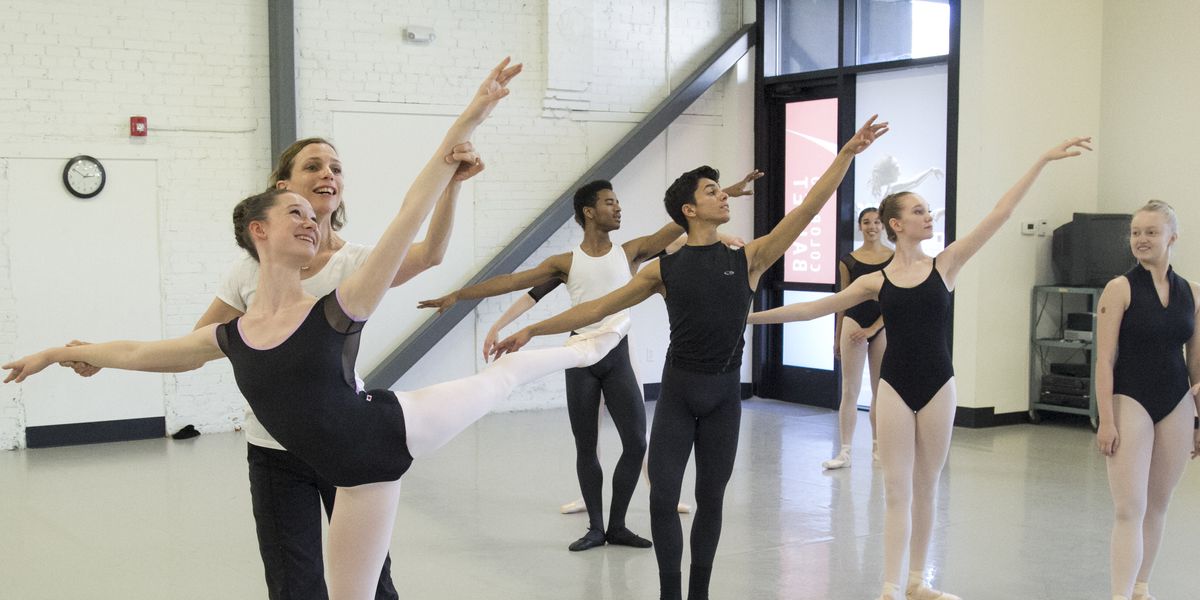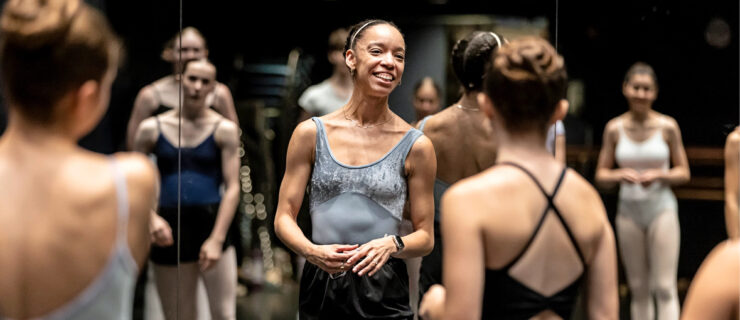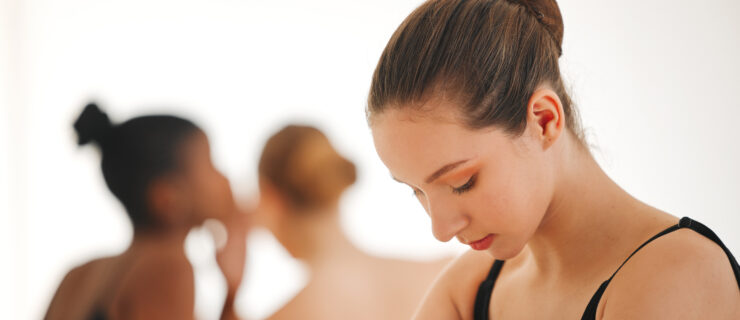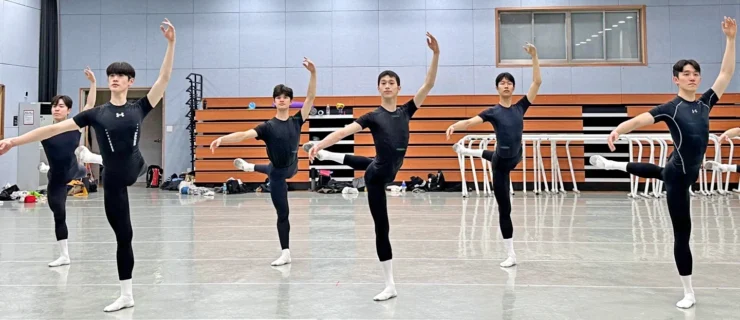These 5 Bad Habits Are Easy to Forget, But Fixing Them Can Take Your Dancing to the Next Level
Striving for higher extensions, more turnout and bigger jumps may be at the top of your agenda in daily class. But what about those finer points of your technique, the subtleties that make a dancer really shine? They need just as much of your attention, and letting seemingly innocuous bad habits linger will impact your overall dancing.
“There are no shortcuts in ballet,” says Cynthia Harvey, artistic director of the Jacqueline Kennedy Onassis School at American Ballet Theatre. “You can’t expect good results by ignoring details that are the building blocks of technique.” We break down five bad habits that are easy to overlook—but have a major impact.
Knuckling
Peff Modelski, a faculty member at Visceral Dance Chicago whose philosophy blends anatomy and Feldenkrais technique with classical ballet, often sees dancers knuckling their toes in an effort to maximize the look of their arches. Yet crunched-up toes in tendus or relevés reduce the ankles’ ability to fully support your bodyweight. Modelski cites one hypermobile dancer who suffered from constant ankle pain and muscle cramping. “It was clear she was using her toes to keep from losing her balance, and was gripping for stability,” she says, even on pointe. Coaching the dancer to point her feet with long, fully stretched toes produced immediate results: She was able to relax her clenched muscles, eliminating her joint pain and bringing new ease to her dancing.
Modelski recommends practicing tendus with lengthened toes and slowly rolling up and down from relevé in parallel, working for the smoothest movement possible. Notice how your balance is affected. “Ask yourself questions to make a routine of awareness: Where is the weight on the bottoms of my feet? Is it the same in first position, fourth or fifth? When I roll up and down does my body move as one piece? Am I able to turn my head without losing my balance?” Doing so leads to higher-quality pointework, smoother weight transfers and easier balances.
Crunched-up toes in tendus or relevés reduce the ankles’ ability
to fully support your bodyweight.
Upper-Body Tension
“Relax your neck!” is a common refrain in ballet class, but upper-body stiffness is more than an aesthetic concern. Master teacher Elena Kunikova says tension leads to larger technical difficulties.
“A stiff neck is a result of a dancer being unfamiliar with, and afraid of, moving her head,” she says. “Therefore, the inner ear isn’t being trained to adequately manage equilibrium and spatial orientation, so the ability to turn, balance and change direction is hindered.” Coordinating head, eye and arm movement is key to eliminating tension and gaining easier balances.
Kunikova’s own training at the Vaganova Ballet Academy taught her to follow her hand’s movement with her head, and she insists her students do the same. “I give exercises to synchronize their movements,” she says. “For example, I instruct them to focus their eyes and really see the fingers while they practice port de bras. This not only achieves a natural quality, it trains our heads to sustain balance.”
Building upper-body coordination into every combination helps cure a related bad habit: shapeless hands. Kunikova suggests concentrating on the shape and movement of the fingers while shifting between basic arm positions (for example, from a rounded first position to an elongated arabesque). “Fingers should move like grass or seaweed,” she says. “Soft, pliant, lively but not stiff.”
 Thinkstock
Thinkstock
Incorrect Arm Placement at Barre
Since barre work is meant to set you up for center, it makes sense that your placement there should be the same. But Colorado Ballet Academy principal Erica Fischbach says all too often students hold the barre incorrectly, causing them to grip their muscles instead of gaining strength through good alignment. Everything from turnout to partnering skills is directly affected.
“The elbow should be slightly forward, so if you pick your hand off the barre, you’re already in second position,” says Fischbach. “If your elbow’s behind you, your shoulder is forward, your upper body is twisted, and you have to compensate by shifting your hips so they’re not over your feet. And if your rear is out behind you, you can’t turn out. It’s a domino effect.”
In class, Fischbach illustrates how much upper-body placement matters by having two students “partner” each other, with one person offering his or her hand as if it were the barre. “They try to do a rond de jambe en l’air, but start to pull their elbow behind them, and everyone falls down. It shows them how all the muscles work together as a whole, and for smooth control you need your placement.”
 Thinkstock
Thinkstock
Fuzzy Spotting
The ideal mechanics of spotting, says JKO School’s Cynthia Harvey, are misunderstood and undervalued. It’s more than just whipping your head—the eyes must focus, too.
Intense concentration at barre often causes dancers to let their eyes “glaze over,” a habit that becomes especially detrimental during pirouettes. The quality—and quantity—of turns depends on clearly seeing what you’re spotting. “Taking your head around without returning your eyes to the same spot can throw you off, and will certainly affect continuous turns,” says Harvey. “Returning your eyes to a focal point really helps.” A great way to practice is by spotting a sign or lettering on the wall. Reading the words with each revolution will train your eyes to really focus.
Remember how powerful eyes are as communication tools, too—your face shouldn’t get cloudy once your fouettés are finished. “Relying simply on the technical aspects won’t make a person a good dancer if they can’t convey anything, and ‘speaking’ with the eyes is part of that,” Harvey notes.
“Focus and direction of the eyes are equally important to technique and can transform a good dancer into a superb one.” —Cynthia Harvey
Ignoring the Music
Dancers with a keen sense of rhythm and phrasing immediately stand apart from those who merely dance on the correct counts, but musicality is a skill that can also be taught—and learned. And since technique and artistry go hand in hand, they must be developed together, says Houston Ballet Academy’s Claudio Muñoz. The key is learning to not just hear the music but understand it.
In Muñoz’s classes, students are challenged to think about how the music and combinations fit together, and why both beat and melody matter. “I gather the students around the piano and ask one to suggest what music would be proper for the exercise, and then to sing the melody they think is appropriate,” he says. “The pianist plays several rhythms until the student makes the best selection.”
Musicality starts with accuracy: listening for the beats within each phrase and making sure not to rush ahead or lag behind. Starting at barre, think about where you should be on each beat of a 3/4 waltz, for example, by counting the 1-2-3 within each phrase. When the teacher shows a combination, consider how many counts each step has: Is the tendu in half a count, one or two? Should you begin to move on 8 or “and”? How long can you hold fifth position before moving from it? Fine-tuning your timing can elevate your dancing to the next level. “It’s the details like musicality that make a dancer unforgettable in the eyes of the audience,” says Muñoz. “Without them, it becomes just movement, not art.”
 Claudio Muñoz leading men’s class at Houston Ballet Academy. Photo by Cameron Durham, Courtesy Houston Ballet.
Claudio Muñoz leading men’s class at Houston Ballet Academy. Photo by Cameron Durham, Courtesy Houston Ballet.






